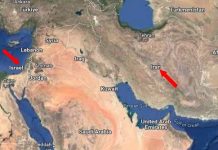
March 30 (UPI) — Boasting that it’s a result of a multilateral nuclear deal, OPEC-member Iran said its trade volume with oil-rich Russia could pass the $10 billion mark.
Iranian President Hassan Rouhani hosted a dinner Tuesday night in Moscow for Iranian nationals living in Russia. As a result of improved opportunities, annual trade between the two counties is on pace to pass $10 billion.
“It takes several years for the people to know all the aspects of the Joint Comprehensive Plan of Action,” the Iranian president was quoted by the official Islamic Republic News Agency as saying.
Iran secured relief from sanctions under the multilateral deal in exchange for agreements to scale back its nuclear research program. Iran and Russia are close nuclear partners, with the latter providing fuel for the former’s Bushehr nuclear plant.
After clearing a debt load to its Iranian counterparts in early 2016, Royal Dutch Shell become one of the first companies to buy Iranian crude oil in the post-sanctions era. Last week, Iran reported a vessel loaded with its crude oil had docked its shipment for the market in Belarus.
Iranian trade representatives raised the possibility of oil swaps and refinery construction during a visit to Moscow in late 2014. Russian Energy Minister Alexander Novak in February said both sides were revisiting that deal with a focus on securing 100,000 barrels of oil per day from Iran under modified terms. Iranian officials at the time said that deal could materialize in March, though no announcement has surfaced so far.
Russian energy company Gazprom, however, announced it signed a memorandum of understanding with the National Iranian Oil Co. during Rouhani’s visit to Moscow.
“The parties will examine the avenues for cooperation in the field of hydrocarbon prospecting, exploration and production within Iran,” the Russian company announced in a statement.
Both sides are party to an agreement led by the Organization of Petroleum Exporting Counties to limit production in an effort to balance the market. Russia is contributing as a non-member state, while Iran is the only OPEC member with room for growth as it looks to regain a market share lost to sanctions.
The deal is aimed at restoring balance to an oversupplied market. A previous OPEC policy of defending a market share with strong production, coupled with higher U.S. crude oil production, helped push crude oil prices below $30 per barrel last year.






It’s important to remember that Putin is perfectly willing to toss Iran on the proverbial junk heap of history if it suits his purposes and for the mullahs in Tehran, they know they are beholden to Russia for saving their collective bacon in Syria. This is not an alliance built to last but rather an alliance that has two wolves eyeing each other for their next meal. Russia is wary of Iran and the spread of radical Islam in its southern territories and is focused on shoring up the price of oil, while Iran wants to widen its oil market and expand its Shiite sphere of influence. Ultimately Rouhani’s visit is to help bolster his image before the May elections, while Putin is humoring the Iranians until he decides if he needs them to continue the war in Syria.